Ball Reviews
Review: Callaway Chrome Soft golf balls
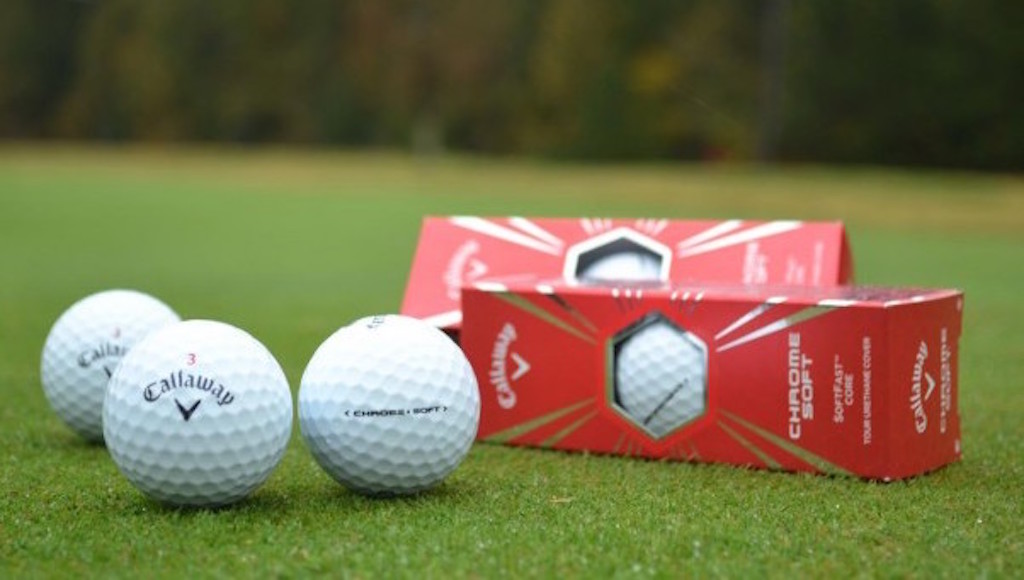
Pros: The Chrome Soft has an incredibly soft feel, but doesn’t skimp on performance. It will create maximum distance off the tee for 99 percent of golfers, yet offers short-game spin that rivals more expensive models.
Cons: Golfers with high swing speeds (105+ mph) — a.k.a. the 1 percent — may lose a few yards off the tee due to the Chrome Soft’s low-compression design.
Who They’re For: Any golfer can play the Chrome Soft.
The Review
Last year, Callaway released the Speed Regime golf ball line, which offered three different golf balls designed for different swing speeds, all with slightly different levels of compression and design. While this gave golfers the ability to really “fit” a golf ball to their game, more choices doesn’t always translate into better decision-making.
With its new Chrome Soft golf balls, Callaway has released just one ball, with one set of specifications, designed to provide a benefit to all golfers regardless of their swing speed.
The three-piece Chrome Soft, with a low-compression Soft Fast core and extremely soft DuraSpin cover, generates lower spin off the driver and long irons for more distance, while generating tour-level spin with shorter irons and shots around the green.
Let’s Talk Core
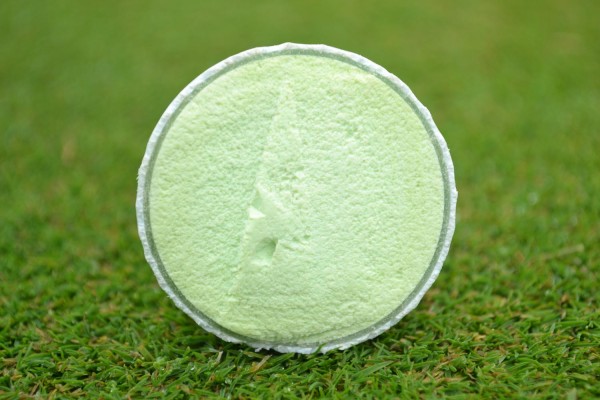 The Chrome Soft is all about the core, and since Callaway is devoting advertising space to actually talking about the compression of the golf ball, let’s dig into it a bit more.
The Chrome Soft is all about the core, and since Callaway is devoting advertising space to actually talking about the compression of the golf ball, let’s dig into it a bit more.
Thanks to a brand new SoftFast core, as Callaway calls it, the ball has a compression rating of 65. By comparison, last year’s Callaway SR-3 had a compression of around 105. Typically, the softer the core, the more the ball deforms at impact. This is great for slower swing speed players who need the ball to deform more so it can spring back into shape and generate more distance. But faster swing speed players can actually lose distance if the ball is too soft. After experimenting with 39 different prototypes, however, Callaway was able to create the right combination of the core and mantle layer so the Chrome Soft retains the energy from impact and keeps ball speed high — even at faster swing speeds.
The Chrome Soft is available now in White, Soft Yellow and Truvis Technology with an MSRP of $37.99. Custom player numbers and personalization is also available.
Performance
We put the new Chrome Soft to the test against the Callaway Speed Regime SR-3, which I tested last year.
Compared to the Speed Regime line the Chrome Soft should:
- Feel softer off every club, with slightly better durability.
- Generate less spin off the driver.
- Create more spin off shorter irons.
Like all reviews, I tested these on the range, on the course, and on a launch monitor with a 60-degree wedge, 6-iron and a driver. I headed to BridgeMill Golf Academy and worked with head pro Tom Losinger to get the data using a Trackman in his indoor studio.
60-degree full wedge shots
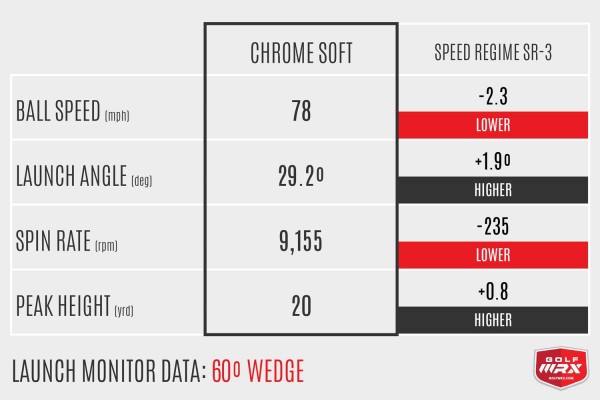
Main differences we expect to see: The Chrome Soft should generate more spin on full wedge shots.
What the data actually shows: Exactly what we expected to see. The Chrome Soft generated 200 rpm more spin than the SR-3, while launching lower and hitting a slightly lower peak height. I did, however, see a big difference in ball speed and carry distance, with the Chrome Soft flying three more yards on average.
Increased ball speed or carry distance with the shorter irons is not typically on the list of requests from better players. In this case, it’s a by-product of the new SoftFast core and three more yards of carry with a 60-degree wedge is fairly significant. That 10-foot putt for birdie is now almost 20. These types of gains will require an adjustment.
What I saw on the course: This ball was perfect inside 100 yards. If it was flying farther than other balls I’ve played, I didn’t notice. The trajectory on full wedge shots was nice and low compared to other balls, and I was already able to notice a difference in feel between the Chrome Soft and the SR-3. A difference of 200 rpm of spin wasn’t noticeable on the course, as both balls performed very similarly when they hit the green.
6-iron shots
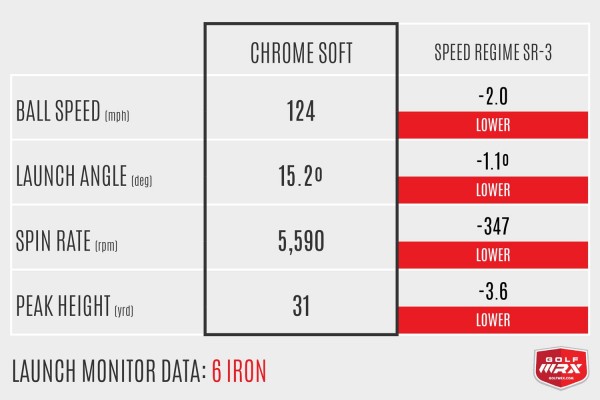
Main differences we expect to see: The Chrome Soft should generate faster ball speeds and less spin than the SR-3.
What the data actually shows: The data backed up the expectations when it came to ball speed. However, I actually saw more spin on my 6-iron compared to the SR-3 and even other tour balls. This could be due to a variety of factors concerning my individual swing, and other golfers might see less spin off their mid irons. Compared to the SR-3, the Chrome Soft launched a little higher, with more spin and ball speed, allowing it to carry a little more than one yard farther. It also hit a higher peak height with a steeper descent angle.
What I saw on the course: I was probably most impressed with the Chrome Soft with the mid to long irons. Yes, the ball performed great off the driver, but the softer feel was very apparent with an iron in my hands. Launching shots with mid to long irons had a more effortless feel. I was also able to get some nice height and spin on my longer irons without sacrificing distance, so I could land shots on the green and see them stick, instead of hitting and running off the back.
Driver shots
Main differences we expect to see: The Chrome Soft should spin less, but still generate more ball speed than the SR-3.
What the data actually shows: I’m a borderline high-speed guy with the driver. My average swing speed is around 106 mph — right on the borderline where golfers can start to “over-compress” the Chrome and possibly lose distance.
You may have read editor Zak Kozuchowski’s reviews on GolfWRX, who can generate more than 115 mph of swing speed with his driver. In his on-course testing, he said he hit the Chrome Soft about the same distance as other tour balls.
“If they liked everything else about the ball, I can’t imagine a golfer who swings 105+ mph wouldn’t play the Chrome Soft just because it was a few yards shorter than a higher-compression tour ball off the tee,” he said. “If a soft feel is important to them, that’s going to take precedence over a few yards of extra distance. And they’ll get those few yards back with their long irons, anyways.”
In my testing, the Chrome Soft generated slightly faster ball speeds, and a lot less spin — almost 300 rpm less spin than the SR-3. This translated into an extra 1.5 yards of carry, and more than 5 extra yards of total distance.
What I saw on the course: The distance gains and lower spin appeared to translate to the course. I wasn’t having any issues getting the ball to run out once it hit the fairway. And the distance appeared to be spot on, if not slightly longer.
Around the green
It is always fun to have that moment in a round where you hit the low, checking chip that freaks out your playing partners. I had that moment from about 55 yards away to a back pin, with out of bounds directly behind the green. With a 56-degree wedge, I hit the low shot and right before the ball hit the green, my playing partners were yelling “get down!” But I knew I hit it well and the ball bounced, checked, and then just lipped the cup.
Could I have executed that shot with other tour balls? Yes. But, it is important to know I can execute it with the Chrome Soft. I’m not a short-game wizard like one of Callaway’s more well-known tour pros, but these balls allow me to hit any kind of shot around the green without hesitation.
Putting
The Chrome Soft feels much softer than the SR-3, which was noticeably softer than previous generation Callaway tour balls. The sound profile has a lower, less “clicky” sound that translates into improved feel. The engineers really have brought the incredible feel of the SuperSoft to the tour-level Chrome Soft.
I’ve rolled some beautifully smooth putts with these balls. They are predictable and roll true when you strike them well. While I won’t go so far as to say they are the best feeling golf ball on the market (although they are close), they are the best feeling Callaway golf ball I’ve tested.
Durability
When most people hear “softer cover,” they instantly assume it will be less durable — and for good reason. It is counter intuitive to believe that soft equals durable. I’m not going to pretend to know the science behind it, but the DuraSpin cover is made from Thermoplastic Urethane, which actually becomes more durable the softer it gets.
I’ve played numerous rounds with the same ball, and also completed all the testing with only three Chrome Soft golf balls, so I can back up Callaway’s claims. These balls are definitely durable and can last numerous rounds if you don’t lose them. With fresh wedge grooves, I was getting all the spin benefits and little to no scuffing. I did see some minor scuffs after finding some rocky rough off the tee, but the ball was still playable and I shouldn’t have been over there in the first place!
The Takeaway
If you’ve avoided Callaway balls in the past because of the “clicky” stigma that has followed them around, it might be time to try a sleeve of the Chrome Soft. Many golfers, myself included, really love the feel of the Callaway SuperSoft, but not the overall performance. The Chrome Soft is a marriage of the soft feel of the SuperSoft with the tour-level performance of the Callaway SR-3. With low spin off the driver and the most spin on short irons of the tour balls I’ve tested this year, the Chrome Soft is one of the best golf balls on the market today.
We gave the Chrome Soft 5 stars, but one of our editors made the case that on a scale of 1-10, the Chrome Soft is an “11.” If you’ve seen the movie Spinal Tap, you know what he means.
See what GolfWRX Members had to say about the Chrome Soft in our Official Forum Testing Thread.
[wrx_retail_links productid=”12″]
- LIKE267
- LEGIT34
- WOW18
- LOL3
- IDHT5
- FLOP1
- OB2
- SHANK24
Ball Reviews
Is the Future of Golf Balls Lower Spin?
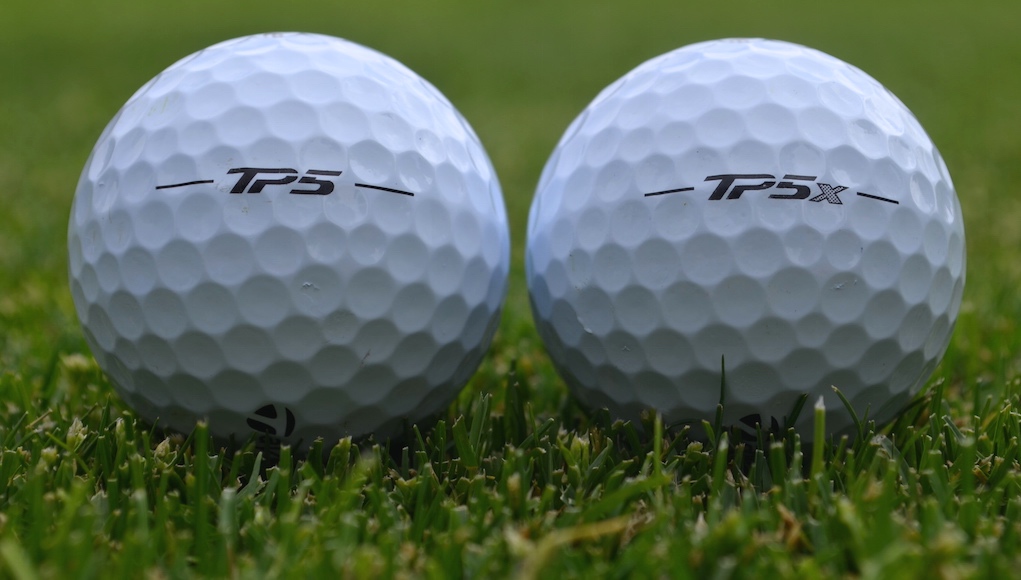
For years now, TaylorMade has been preaching lower spin to create more distance, especially in its drivers. Its original SLDR driver was actually so low spinning that TaylorMade encouraged golfers to try higher-lofted club heads, or to “loft up,” so golf balls wouldn’t dive out of the air. Now, when you look around at the popular drivers in the industry, most of them are designed to lower spin. TaylorMade was ahead of the curve.
With its new TP5 and TP5x golf balls, TaylorMade is pushing a similar initiative: lower spin on all full shots.
“This ball is different. You can make the argument this is too hot a golf ball for people who don’t spin it (enough). But that’s not the large percentage of golfers.”
For driver shots, it’s easy to understand the benefit of lower spin as long as the golfer launches it high enough. Low spin plus high launch equals more distance; that’s just a math equation. But with golf balls, as opposed to drivers, their jobs are also to get close to the hole, not just go as far and straight possible. With that in mind, is lower spin necessarily beneficial on ALL full shots, including the irons?
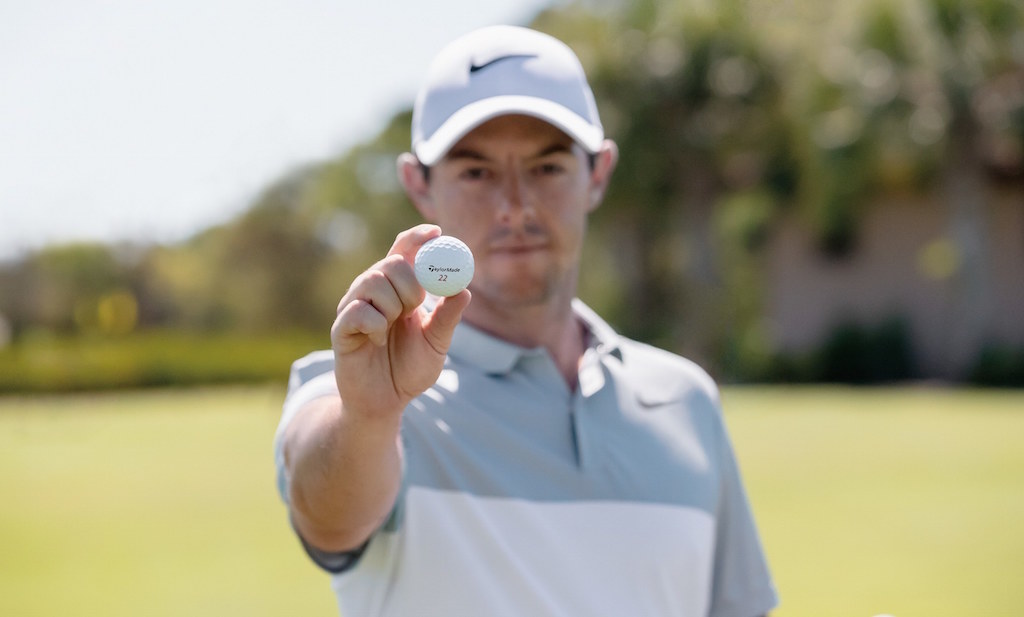
For Jon Rahm and Rory McIlroy, who both switched to TaylorMade TP5x golf ball this season — the lower-spinning and slightly firmer-feeling golf ball in the TP5 line — the answer is clearly “yes.” Rahm saw an 800 rpm drop in iron spin with a 4-iron compared to his Titleist’s Pro V1x golf ball and a 400 rpm drop in driver spin, according to TaylorMade. McIlroy saw up to 10 yards in extra distance with a 5-iron, and he picked up distance with the driver, as well. According to Eric Loper, Director of Golf Ball R&D at TaylorMade, McIlroy was hitting his 7 iron at 16.1 degrees of launch with 6350 rpm, and his 4 iron at 11.1 degrees of launch with 3800 rpm during his initial Trackman testing at The Bear’s Club.
“(With a 7 iron) you have to hit it about 7000 (rpm) or less, and he was hitting (his previous ball) up to 7500 (rpm),” Loper said. “That’s too high… (With the TaylorMade TP5x) he didn’t express any concern with (spin being too low). It was launching high, getting to its apex and landing soft.”
Hoyt McGarity, President of True Spec Golf, an internationally renowned custom club fitter with more than a dozen locations, has seen similar performance gains with TaylorMade’s TP5x golf ball through his personal testing and his testing with Tour players. He said he’s seeing 2-3 mph more ball speed compared to other golf balls. Just as importantly, he’s seeing those gains with a higher ball flight in what he called “straight up” club tests.
“Some of the Tour players — straight up, same loft, same lie, same golf club, same everything — they would launch this golf ball almost a degree higher, which is amazing,” McGarity said. “I was seeing almost 2-3 mph more ball speed for these Tour players, not that they need more distance, but I’m like, ‘You’re launching higher and it’s going further and it’s still coming in soft; it’s not coming in low and hot. It’s coming in high and still soft, so what’s the disadvantage?’ If you’re a low-ball hitter with low spin, you might have some issues. Your half shots might be tough to control the distance on it, that’s all.”
So while TaylorMade’s TP5 and TP5x golf balls are designed to go farther and with less spin on full shots, the company says their steeper landing angles will help them stop nearly as fast as higher-spinning balls. TaylorMade’s belief is based on the company’s scientific bounce-and-roll calculations, which factor in green conditions and landing characteristics. Yes, the lower spin of its golf balls in relation to competitors leads to minimally more roll out, but the amount is insignificant according to TaylorMade: an additional 1-1.5 feet. The company also points out that with a longer-flying golf ball, golfers will be hitting shorter clubs into greens, leading to more control. An 8 iron will yield greater stopping power and accuracy than a 7 iron, right?
Expert fitter Scott Felix of Felix Clubworks agrees with TaylorMade in theory. He said that as long as the golf ball is coming into a green at a steep enough angle, low spin is not a problem for approach shots.
“Most golfers spin the ball too much with their irons, costing them distance,” Felix said, “…but for golfers who already have a flat trajectory (with their irons), lowering spin won’t help them hold the green.”
McGarity added that about 80 percent of golfers who come to him for a fitting spin the ball too much, and for Tour players, the drop in spin won’t have a detrimental effect.
“Lets say the average spin on Tour is 6,000 (rpm with a 6 iron); it’s not like [TaylorMade’s TP5x golf ball is spinning] around 4,000 (rpm),” McGarity said. “If your average land angle is 49 degrees, they’re hitting these balls at say 5800 spin, which I think is great, and with a 50-degree land angle, so what’s the harm? It’s not like it’s coming in at 44 degrees; that’d be probably a one hop over the back and get into a little trouble.”
On the other hand, Felix notes that some Tour players simply want maximum control from a golf ball due to firmer fairway and green conditions, so lowering spin isn’t always the best option for them. But for average golfers, the distance gains will be beneficial.
“Most golfers aren’t playing in Tour conditions and will simply benefit from hitting the ball farther and having shorter irons into the green,” Felix said.
McGarity also warns golfers who already play low-spinning irons and drivers, and who spin the ball below 2,000 rpm with the driver, that the TP5 and TP5x golf balls may not be for them.
“This ball is different,” McGarity said. “You can make the argument this is too hot a golf ball for people who don’t spin it (enough). But that’s not that large percentage of golfers.”
After announcing an equipment contract with TaylorMade at The Players Championship, Rory McIlroy called TaylorMade’s TP5x golf ball the most important factor in his decision to sign with the company. With the new ball, he said he not only picked up distance, but consistency and control in the wind.
“I wasn’t really happy with the golf ball I was playing, and I needed to do something,” McIlroy said. “I felt like I struggled in the wind. So I sort of went back to the drawing board and tested for about 10 days pretty extensively after Augusta … I worked with the TaylorMade guys one day and started just on Trackman on the range and saw stuff with the golf ball … I thought, ‘Wow, this is what I need.’ This is exactly the thing that I’ve been struggling with.”
McGarity’s experiences confirmed McIlroy’s sentiments.
“I picked up a half club and I sit around and hit balls all the time on Trackman, so for me to pick up a half a club, it’s not the club it has to be the ball,” McGarity said. “And into the wind I can definitely see it’s more penetrating. I’m not a super high-spin player, so some shots I’ll hit the ball farther than I expected, but I’d rather have that issue than (to hit it) short.”
So there’s agreement that the ball spins less, goes farther and performs better in the wind with irons. But when fitting a golf ball, is iron play even the best place to start? Golf is about more than just iron shots, after all.
For Felix, a ball fitting begins by having a client hit “a bunch” of different golf balls on the putting green to narrow it down to a few based on feel preferences. Then he has the golfer take those golf balls to the chipping green and bunker. He then works back to 40-yard shots, narrowing down the options throughout the process based on feel and performance. After that, golfers will progress to the driver, and then to the irons.
“Usually you want to get a few balls you really like on and around the greens, then work backwards from there,” Felix said.
Initial testing for McIlroy started on the golf course, and not on Trackman, according to TaylorMade representatives. Once he became comfortable with performance and feel, he then took to Trackman to get dialed in with spin and match the golf ball to his equipment.
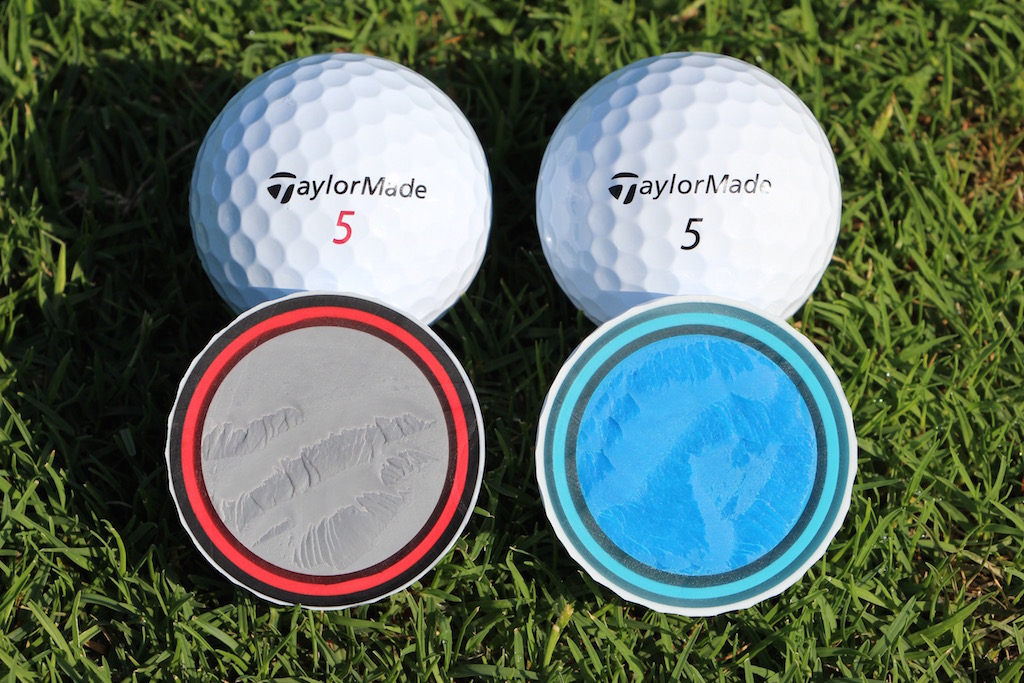
TaylorMade’s TP5x and TP5 golf ball (right), which has a slightly firmer feel.
Despite the low-spinning qualities of the golf balls on full shots, TaylorMade believes it’s giving up nothing to the competition in terms of short game performance. “There’s no golf ball that spins more around the greens,” a TaylorMade representative told me. That’s a legal way of saying no other golf ball company can prove, with confidence, that its golf ball spins more around the greens.
By producing extremely low spin on full shots, but without giving up performance and feel around the greens, TaylorMade says it’s providing the best qualities from each end of the spectrum with its TP5 and TP5x golf balls. But… how? TaylorMade engineers accomplished the feat by using larger and softer-compression cores. TaylorMade says the cores “activate” at 70 mph of swing speed inside of the five-piece constructions, which also have firm mantle layers and soft, urethane covers. The result is low spin on full shots, and high spin on shorter shots.
“It’s the real first golf ball (TaylorMade has) made that’s a game changer,” McGarity said.
TaylorMade does admit, however, that golfers may be sacrificing a bit of “workability” with the irons. That’s to say hitting hooks and slices with its golf balls becomes more difficult due to the lower spin. While the TP5 will offer a bit more of that control than the TP5x, it’s definitely something to keep in mind for those who prefer to play a Bubba Watson-style of golf.
Looking to the future
So does all of this mean that lower-spinning golf balls on full shots are the future of golf? Will we see golf equipment companies striving for drastically lower spin over the next few years?
TaylorMade representatives say they continue to chase lower spin in their prototyping, and until the golf ball is diving out of the air to the golfer’s detriment, lower spin is the future of golf balls. Obviously, TaylorMade is fully committed to a lower-spinning golf ball, and lower spin in general throughout its product lines.
For other premium golf ball manufacturers, bringing lower-spinning options to the market seems likely, given the performance benefits and Tour validation of TaylorMade’s new golf balls. But there’s a reason there are so many variations of golf balls on the market; every golfer is different. Some need more spin with the driver and want more workability with the irons, some want a super firm feel and others just want the cheapest ball possible.
Golfers should view TaylorMade’s TP5 and TP5x golf balls as options in the vast marketplace of golf balls, and perform thorough testing to figure out if this is the right line of golf balls for their game. And remember, lower spin and more distance will require recalibrating your iron distances, and possibly adjusting your equipment, so a mid-season switch is recommended only to those who are willing to put in the necessary work.
- LIKE311
- LEGIT52
- WOW18
- LOL8
- IDHT2
- FLOP6
- OB2
- SHANK79
Ball Reviews
Review: Callaway Chrome Soft X Golf Balls
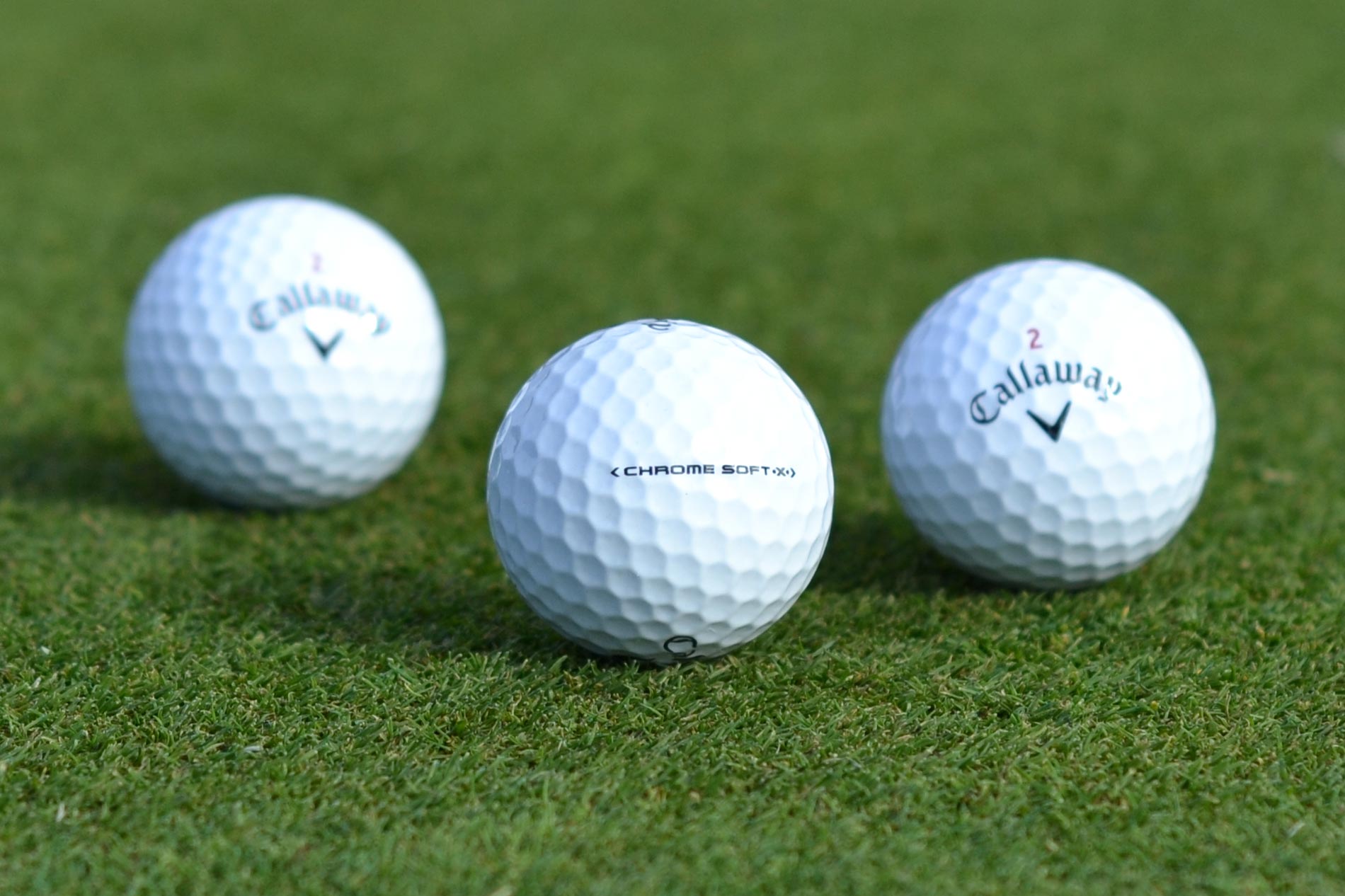
Pros: Incredibly soft feel like the Chrome Soft, but the Chrome Soft X increases spin through the bag to give better players more control.
Cons: Golfers who struggle with too much slice or hook won’t find it any easier to keep shots close to the target with the Chrome Soft X.
Who They’re For: Better players with higher swing speeds looking for a soft-feeling ball that checks up faster with iron shots than Chrome Soft.
The Review
Callaway says the Chrome Soft is “the ball that changed the ball,” and in many ways that’s true. It’s a tour-level golf ball with a softer feel, less spin through the bag and even a lower price point ($39.99) than some other tour balls in its category.
The Chrome Soft is Callaway’s best ball option for the vast majority of golfers (and received a 5-star rating by GolfWRX), but it isn’t for everyone. Callaway’s solution for them is its new Chrome Soft X golf ball.
What’s New in the Chrome Soft X
The original Chrome Soft golf ball, launched in 2015 had the very soft compression of 65. When Callaway released the 2016 version of Chrome Soft, it gave the ball a slightly higher compression (75), which improved its consistency on short-iron shots. The compression of its new Chrome Soft X is 90.
The reason for the higher compression has to do with the low-spin profile of the Chrome Soft, a blessing to most golfers as it helps their shots fly straighter and farther. It’s not ideal for some tour pros and better golfers, however. We’re talking about the kind of golfers who have great mechanics and strike shots consistently on the center of the club face. They often have a ball flight that is so dialed in that the lower-spinning performance of the Chrome Soft makes their shots harder to control. To address that small but important segment of the golfing population, Callaway created the higher-spinning Chrome Soft X.
Under the hood, Callaway used a slightly thinner urethane cover, increased the size and hardened the compression of the Dual SoftFast core, and enhanced the HEX Aerodynamics. As a result, the Chrome Soft X should generate more ball speed and spin through the entire bag.
Dave Bartels, Callaway’s Senior Director of Golf Ball R&D, says golfers will be able will notice the differences and have a clear favorite. “We expect that golfers who like the Chrome Soft X probably won’t like the Chrome Soft very much, and vice versa.”
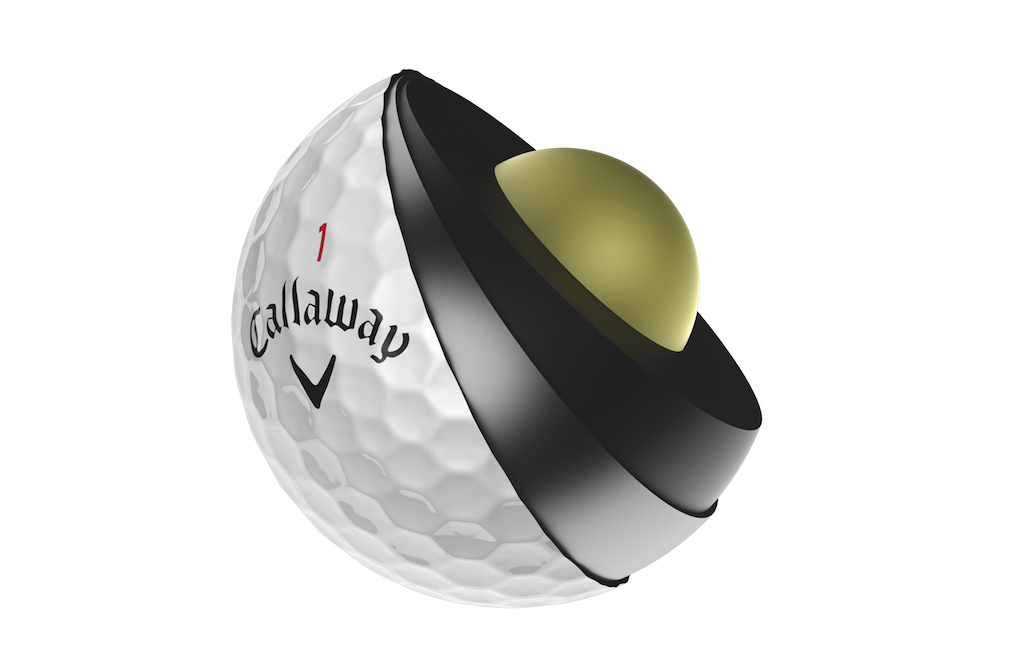 The Chrome Soft X ($39.99) will be in stores February 3 in White and Yellow.
The Chrome Soft X ($39.99) will be in stores February 3 in White and Yellow.
Performance
Since the Chrome Soft X is meant to be a complimentary golf ball to the Chrome Soft, we tested them head-to-head.
Compared to the Chrome Soft the Chrome Soft X should:
- Feel almost as soft as the Chrome Soft with the same durability.
- Generate more spin where better golfers need it.
- Generate faster ball speeds.
Like previous reviews, I tested these on the course and on a launch monitor with a 60-degree wedge, 6-iron and a driver. To allow me to re-hit each ball numerous times, I completed the testing indoors on a camera-based SkyTrak launch monitor. To keep the numbers as consistent as possible between the balls, I threw out and re-hit any shots that were not struck on the center and did not land within a designated target zone for each club (Wedge: +/- 3yards, 6 Iron: +/- 8 yards, Driver: Target width of 40 yards).
But I’m not a robot, so take that into account.
60-degree full wedge shots
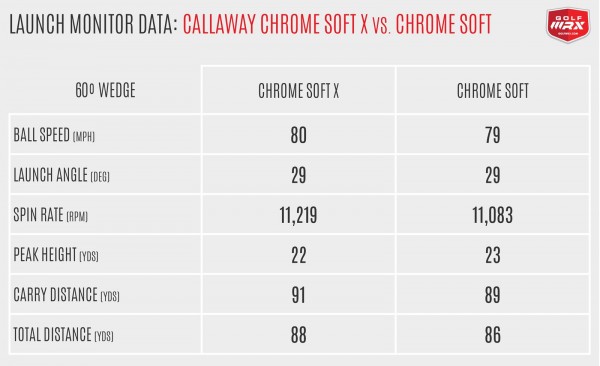 Main differences we expect to see: Not many. If anything, the Chrome Soft X might generate slightly higher ball speeds.
Main differences we expect to see: Not many. If anything, the Chrome Soft X might generate slightly higher ball speeds.
What the data actually shows: Pretty much as expected. Overall, the Chrome Soft X clocked 1 mph more ball speed, 136 rpm more spin and carried 2 yards farther. These are very subtle differences, and for an amateur like me I would not expect to notice a difference on the course.
The larger Dual SoftFast core and higher compression could account for the additional ball speed and carry distance. For me, 2 yards won’t require much of an adjustment. If you are a better player completely dialed in with your distances, you might need to make a minor adjustment.
What I saw on the course: When I’m testing golf balls, I like to drop one down without looking at the label and hit a shot. This allows me to remain unbiased in my expectation and just watch what the ball does. When I did this test with the Chrome Soft X on a full wedge shot, I was instantly impressed. The feel was incredible and the distance was spot on. After the wedge testing, I would’ve put this ball straight in the bag.
6-iron shots
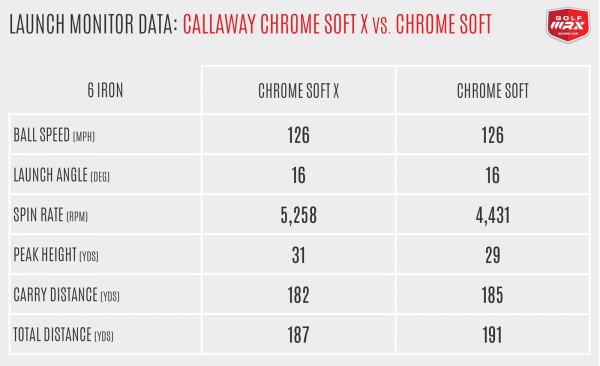 Main differences we expect to see: The Chrome Soft X should generate faster ball speeds and more spin than the Chrome Soft.
Main differences we expect to see: The Chrome Soft X should generate faster ball speeds and more spin than the Chrome Soft.
What the data actually shows: The Chrome Soft X is continuing to spin more through the bag. Ball speeds were slightly higher by about 0.8 mph. The Chrome Soft X generated a considerable amount of additional spin, but also flew slightly higher and had a steeper descent angle.
Just like you’ll see with the driver below, the additional spin decreased my distance (the Chrome Soft X averaged 3 yards less carry and 4 yards less total distance), but increased my stopping power.
What I saw on the course: Just like previous Chrome Soft balls, the feel off the club face with mid irons was very soft. I really noticed the additional spin on the course, as my draw shot shape started to get a little more curve to it and my shots stopped faster on the greens. I felt like I was able to attack greens with longer irons, flying shots all the way to the hole instead of playing a little short and letting the ball release more.
Driver shots
Main differences we expect to see: The Chrome Soft X should spin more slightly more and deliver higher ball speeds than the Chrome Soft.
What the data actually shows: I am not a high swing-speed player. My average playing swing speed is around 105 mph, which is generally considered the cut-off before you have a “high swing speed.” Also, I am not a low-spin player, so having a ball that can spin a little more might not be the best for my specific game. Based solely on that, I would not expect to see the full benefits of the Chrome Soft X
The testing backs this up. The Chrome Soft X delivered the same ball speed, but with 432 rpm more spin. Bartels says Callaway’s testing has shown golfers either spinning the Chrome Soft and Chrome Soft X the same off the tee, or an increase of 100-200 rpm with the Chrome Soft X. He called 400 rpm “within the ballpark,” but not typical.
Just to be clear, we’re talking about a change in performance that resulted in just 1 yard less carry distance and 3 yards less total distance; basically nothing.
What I saw on the course: As my launch monitor data showed, the Chrome Soft X appeared to fly higher and not roll as much when it hit the ground.
The one place I saw a benefit to the Chrome Soft X was when I contacted a drive high off the club face. With the Chrome Soft, these drives fell out of the sky more quickly, costing me carry distance. With the Chrome Soft X, they stayed in the air a little longer. It’s clear for low-spin players, or those with already optimal launch conditions, the Chrome Soft X can provide as good, if not better performance.
Around the Green
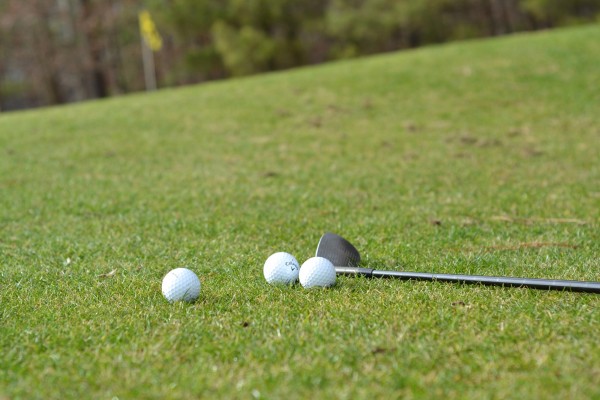 There is nothing this ball can’t do around the greens. I don’t have a tour pro’s arsenal of short game shots, but I do know the difference between a ball that can do anything and a ball that can do only some things.
There is nothing this ball can’t do around the greens. I don’t have a tour pro’s arsenal of short game shots, but I do know the difference between a ball that can do anything and a ball that can do only some things.
I put the Chrome Soft X through the paces of low spinners, high flop shots, bump and runs, and bunker shots. As expected, it performed identically to the Chrome Soft.
Putting
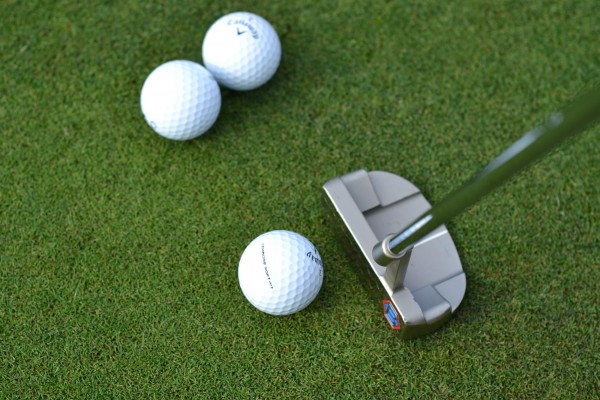 Putting one right after the other, if you are really paying attention, the Chrome Soft X feels slightly firmer off the putter face with a slightly higher-pitched sound than the Chrome Soft. But this ball is soft, smooth and rolls beautifully. I have always loved the way the Chrome Soft feels off the putter, going back to the 2015 ball. Even though it’s slightly firmer, the feel off the putter of the new Chrome Soft X continues to impress me (through the entire bag really).
Putting one right after the other, if you are really paying attention, the Chrome Soft X feels slightly firmer off the putter face with a slightly higher-pitched sound than the Chrome Soft. But this ball is soft, smooth and rolls beautifully. I have always loved the way the Chrome Soft feels off the putter, going back to the 2015 ball. Even though it’s slightly firmer, the feel off the putter of the new Chrome Soft X continues to impress me (through the entire bag really).
Feel is subjective, but I found the Chrome Soft X to be one of the softest tour balls on the market today.
Durability
I completed all my testing with only one ball, so it saw a considerable amount of shots. Like previous Chrome Soft balls, the Chrome Soft X is very durable. It took a beating with the 60-degree and showed only light scuff marks. Both the Chrome Soft X and the Chrome Soft perform very similarly in terms of durability.
The Takeaway
The Chrome Soft X isn’t for everyone and that is why Callaway is marketing the “X” as a complimentary ball to the Chrome Soft and not a replacement.
With the changes Callaway has made, the Chrome Soft X checks off all the criteria for a high-performance premium golf ball. If you thought the 2016 Chrome Soft was a little too soft with too little spin through the bag, the Callaway Chrome Soft X might just be the ball you’re looking for.
- LIKE294
- LEGIT43
- WOW14
- LOL8
- IDHT4
- FLOP8
- OB3
- SHANK25
Ball Reviews
Review: 2015 Titleist Pro V1 and Pro V1x
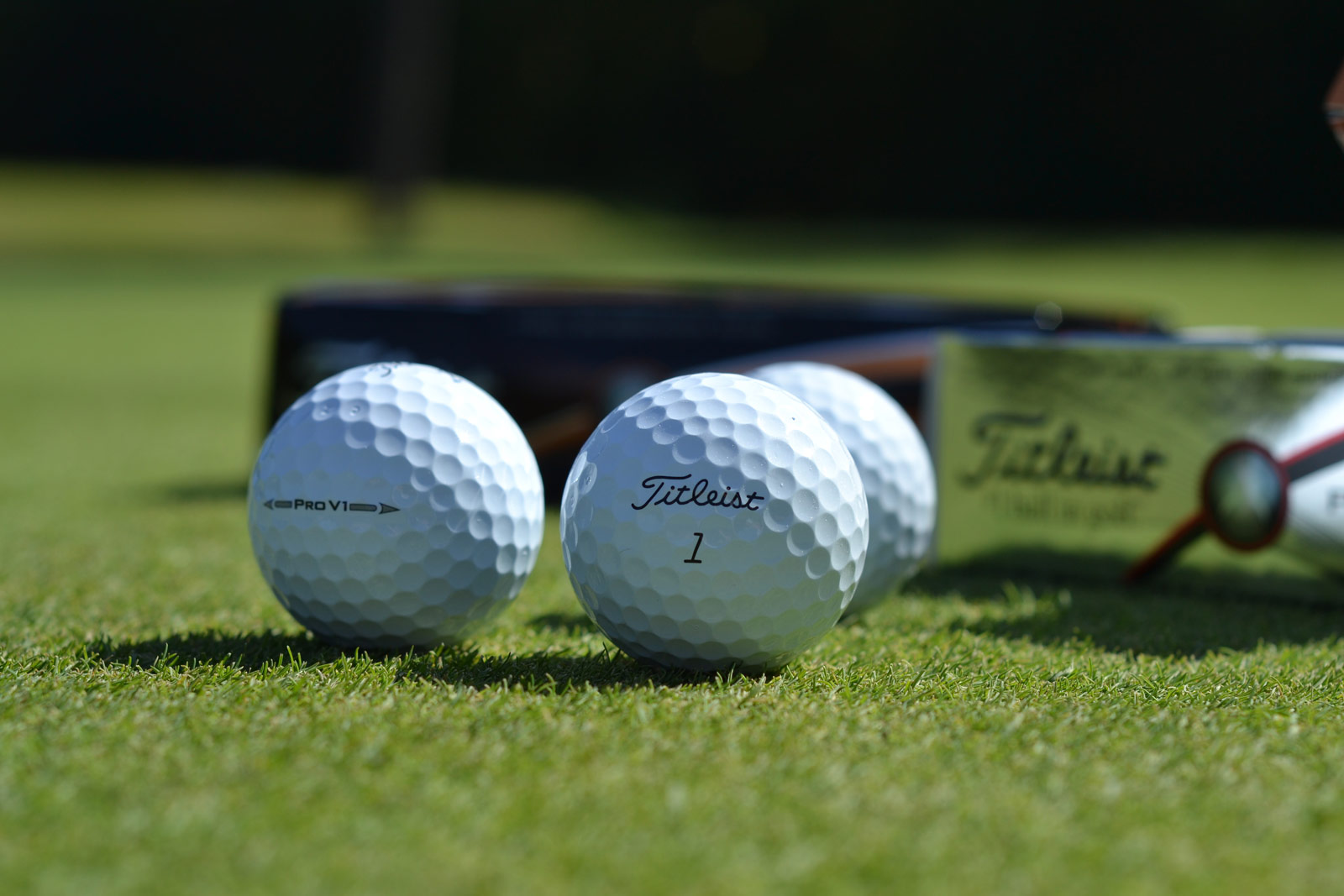
Pros: Golf’s golden standard for distance, consistency and short-game spin. Both the Pro V1 and Pro V1x are softer than previous generations, offering more check around the greens and better durability.
Cons: At $47.99 per dozen, the 2015 Pro V1 and Pro V1X are two of the most expensive golf balls on the market.
Who they’re for: Golfers who want the best blend of distance, trajectory control, short-game spin and feel. The Pro V1 and Pro V1X are Titleist’s best-performing golf balls, regardless of a golfer’s swing speed.
Overview
There is no denying the quality and performance of the Titleist Pro V1 and Pro V1x throughout the years. Sure, there are other golf balls on the market that perform extremely well, sometimes at lower price points, but the Pro V1 line is an icon in golf. Instantly recognizable and known for its consistent performance, each new release builds on the previous.
Titleist hasn’t made any radical changes to the performance of the balls from one release to the next, but they are always improving the Pro V1 and Pro V1x in some way. When they asked tour pros, as well as thousands of amateur testers, what they wanted in the new balls, all they asked for was a bit more spin and softer feel.
And Titleist delivered.
Both golf balls feature a new, thermoset urethane elastomer cover designed to feel softer, increase short-game spin, and at the same time, be even more durable than models of the past.
I don’t want to spend too much time on the technical side of the cover, but I was intrigued to learn it has only ever been designed for use on a golf ball. Most tour balls have a different type of urethane cover, which typically is developed by an outside vendor and not made specifically for a golf ball. Titleist engineers have complete control over the material, and that gives them the ability to make subtle tweaks until they have the exact performance characteristics they are looking for. Hundreds of formulations went into the final 2015 Pro V1 and Pro V1x until they found the perfect mix.
Related: Go behind the scenes at the Titleist golf ball factory
Pro V1
The three-piece Pro V1, just like previous generations, has a softer feel and slightly more long game spin than the Pro V1x. The single ZG process core helps generate low spin off the driver, a more penetrating trajectory and flatter landing angle, which can generate more roll than the Pro V1x.
The brand new cover not only feels softer, but is noticeably more durable than previous generations. Titleist tour pros have already claimed they can play the same ball for an entire round, even with their fresh grooves and higher swing speeds.
Pro V1x
The four-piece, dual-core Pro V1x has a slightly firmer feel, generates even less spin off the driver, and launches higher than the Pro V1. Just like previous generations, the outer core and inner mantle work to deliver the specific trajectories golfers want from fairway woods, hybrids, irons and wedges. The same improved Thermoset Urethane Elastomer cover found in the Pro V1 also is found on the Pro V1x.
The Pro V1 and Pro V1x carry a minimum advertised price of $47.99. Both are available in standard and custom play numbers. Standard numbers come in low (1-4) and high (5-8). Double-digit play numbers, 00 and 11-99, are available for custom order with a minimum order of one dozen.
Performance
If I had a whole closet full of either golf ball, I’d be really happy. Both the Pro V1 and Pro V1x are just that good. But there are subtle differences.
- The Pro V1 should feel softer on every club and generate more spin off the driver.
- The Pro V1x should spin less off the driver, but more with shorter irons.
Like all reviews, I put these to the test on the range and on a launch monitor with a 60-degree wedge, 6 iron and a driver. This time around, I headed to BridgeMill Golf Academy and worked with head pro Tom Losinger to get the data using a Trackman in his indoor studio.
60-degree full wedge shots
Main differences we expect to see: The Pro V1X should generate more spin on full wedge shots than the Pro V1.
What the data actually shows: Exactly what we expected. The spin rate for both golf balls is right around 9,000 rpm, with the Pro V1x generating almost 200 rpm more spin. The difference isn’t huge and you can control spin with both balls, but the edge goes to the Pro V1x.
The flight of both balls was similar, however, and the real difference was in carry and total distance. The Pro V1x actually flew 4 yards farther on average than the Pro V1 for me.
What I saw on the course: Both balls had tremendous drop, stop and back-up power on full and even partial wedge shots. Maybe the pros can tell the difference in a couple hundred rpm of spin, but me and most golfers probably need a launch monitor to be certain. I also did not notice much, if any, difference in distance between the balls, and the ball flight was very similar. I did like the feel of the Pro V1 over the Pro V1x, but now we’re just splitting hairs.
6 iron shots
Main differences we expect to see: As we get down to the mid and longer irons, the Pro V1 should start to spin more than the Pro V1x and also launch a little lower.
What the data actually shows: Every data point was higher with the Pro V1 except carry and total distance, which was only a yard longer with the Pro V1x. I generated quite a bit more spin with the Pro V1, which I expected. But I also had a higher launch and peak height with the Pro V1, which I didn’t expect. Based on that data, I would put the Pro V1 into play and maximize those conditions to help me get the ball up quicker and come down steeper into the greens with mid or long irons. The trajectory wasn’t ballooning; it was just a nice, solid ball flight.
What I saw on the course: The Pro V1 continued to make my job easier with the mid irons. Maybe I just happened to pure every shot when the Pro V1 was in play (not likely) or maybe the launch and peak height numbers truly translated to the course. Even with the more effortless launch, my distance was spot on. I don’t want to take anything away from the Pro V1x, because I love the way it performed. Fitting and testing is important for every golfer, and no further proof is necessary for me than the fact that I played my best mid iron approach shots with the Pro V1.
Driver Shots
Main differences we expect to see: The differences are more clear with the driver. The Pro V1x should launch higher with less spin and more distance than the Pro V1.
What the data actually shows: Well, my data didn’t completely align with the expectations, but it was close. The Pro V1x was longer in carry and total distance by 2 yards and it generated less spin off the driver. It wasn’t a huge difference, but it was lower. That said, the launch angle was very similar and the balls hit the same peak height and had a similar descent angle. The slightly lower spin and higher ball speed is what gave the Pro V1x the edge in distance.
What I saw on the course: Both balls were champions off the tee. I didn’t notice much, if any, distance loss between the Pro V1 and the Pro V1x. If the Pro V1x was longer, it was only by a yard or two. Neither golf ball ballooned up into the wind, and both had the same amount of control side-to-side.
Around the Green
I could list off all the shots you can hit around the green, but I would start to sound like a broken record. Both balls can perform them all, and can certainly handle more shots than I have in my arsenal. The Pro V1, with its softer feel, gave me the illusion of a more sticky feel, but the differences are truly subtle.
So much of what we feel is determined by the sound we hear. It is why club makers spend so much time fine-tuning the sound profile of their clubs. It seems that Titleist consciously tweaked how both balls sound off the club face, which I believe positively contributes to both golf balls feeling noticeably softer than previous generations.
Putting
When it comes to putting, I would choose the Pro V1 every day. It is one of the best, if not the best-feeling golf ball off the putter that I have tested and put in play. It was softer off the face than the Pro V1x, but that is not to say the Pro V1x isn’t soft. In a blind test, where I marked over the product name, I was able to pick out the Pro V1 fairly accurately. I say “fairly” because I wasn’t perfect, which goes to show how good they both feel.
Interestingly, the new, softer cover on the Pro V1x actually made it feel about as soft as the previous generation Pro V1. I’ll give the edge to the Pro V1 here.
Durability
I completed all my testing with just three of each model. The improved cover appears to be working as expected. I could wash these balls off and put them back in play. Even with fresh grooves on my wedges and numerous wedge swings off a tight, clean, indoor hitting mat, these golf balls were highly durable. Yes, there were minor scratches, but nothing that would impact playability and I didn’t notice any difference in durability from one ball to the other.
Given the price, I’m happy to see that if I can keep the ball out of the woods or water, I can go an entire round or more with the same ball.
The Takeaway
I tested the previous generation balls last year, and while the testing was done on a different launch monitor and with different clubs, the comparisons were shockingly similar. Titleist engineers set out to keep everything the same, except figure out how to make each ball softer, more durable and spin a little more. They succeded.
On course, the Pro V1 had a better feel and I shot better scores with it. The data, especially the slightly lower spin off the driver and higher spin off the wedges, suggests I should play Pro V1x. But with the margin between the balls razor thin, I’m going with feel and confidence this time, which means the Pro V1 is going in the bag.
I encourage all golfers to put these balls to the same test, and see what’s best for them. It’s hard to go wrong with either of them, whether you’re comparing them to the rest of Titleist’s line or any other golf ball on the market.
[wrx_retail_links productid=”13″]
Related
- GolfWRX member testing of Titleist’s new Pro V1 and Pro V1x golf balls
- Review: Titleist’s 2013 Pro V1 and Pro V1x
- Titleist DT TruSoft: What you need to know
- LIKE158
- LEGIT12
- WOW2
- LOL3
- IDHT0
- FLOP1
- OB3
- SHANK14
-

 19th Hole3 days ago
19th Hole3 days agoDave Portnoy places monstrous outright bet for the 2024 Masters
-

 19th Hole3 weeks ago
19th Hole3 weeks agoJohn Daly stuns fans into silence with brutal opening tee shot on PGA Tour Champions
-

 19th Hole2 weeks ago
19th Hole2 weeks agoThings got heated at the Houston Open between Tony Finau and Alejandro Tosti. Here’s why
-

 19th Hole4 days ago
19th Hole4 days agoTiger Woods arrives at 2024 Masters equipped with a putter that may surprise you
-

 19th Hole1 week ago
19th Hole1 week agoReport: Tiger Woods has ‘eliminated sex’ in preparation for the 2024 Masters
-

 19th Hole3 weeks ago
19th Hole3 weeks agoCharlie Woods finds it tough going on American Junior Golf Association debut
-

 19th Hole2 weeks ago
19th Hole2 weeks agoAddiction, spinal fusion, and scam artists – Everything Anthony Kim revealed in candid interview with David Feherty
-

 19th Hole1 week ago
19th Hole1 week agoAnthony Kim says doctors told him that he ‘may not have much time left’ ahead of LIV return

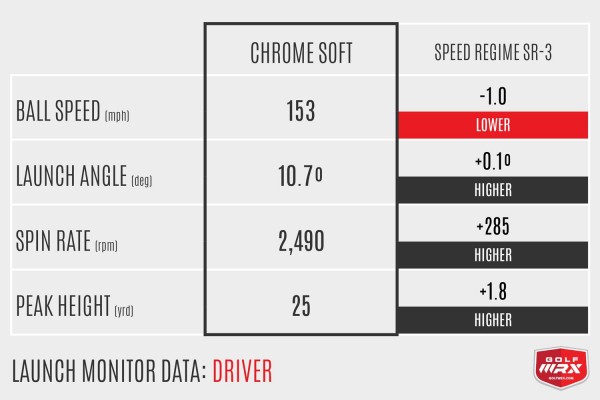
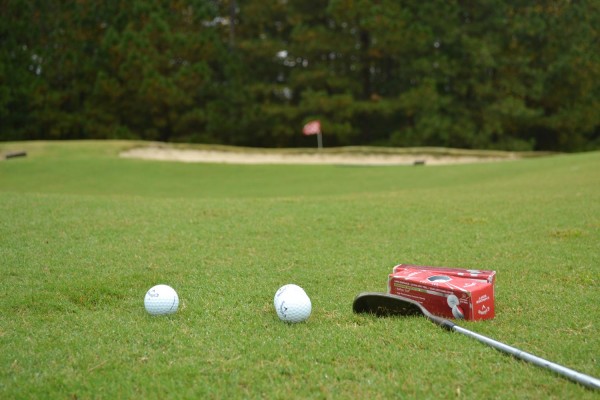
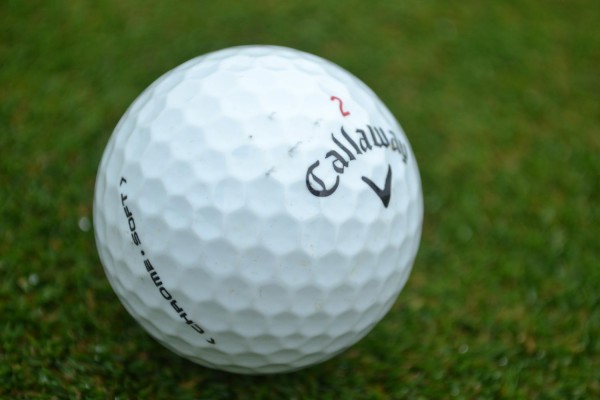


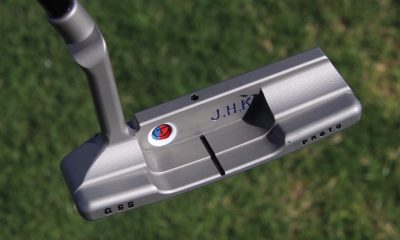







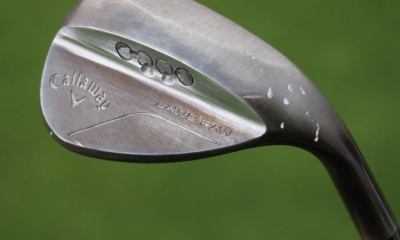





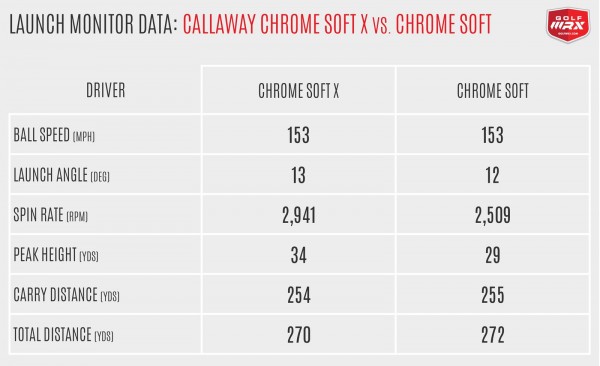
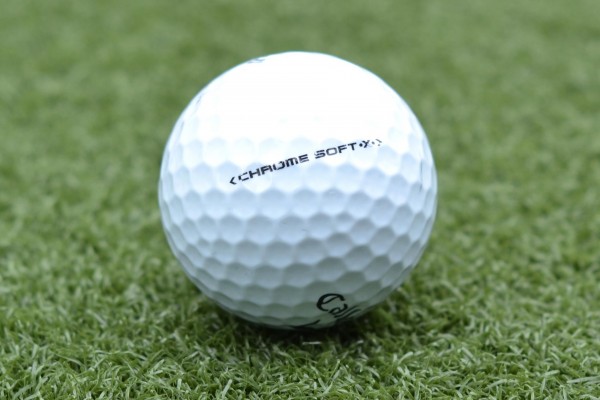

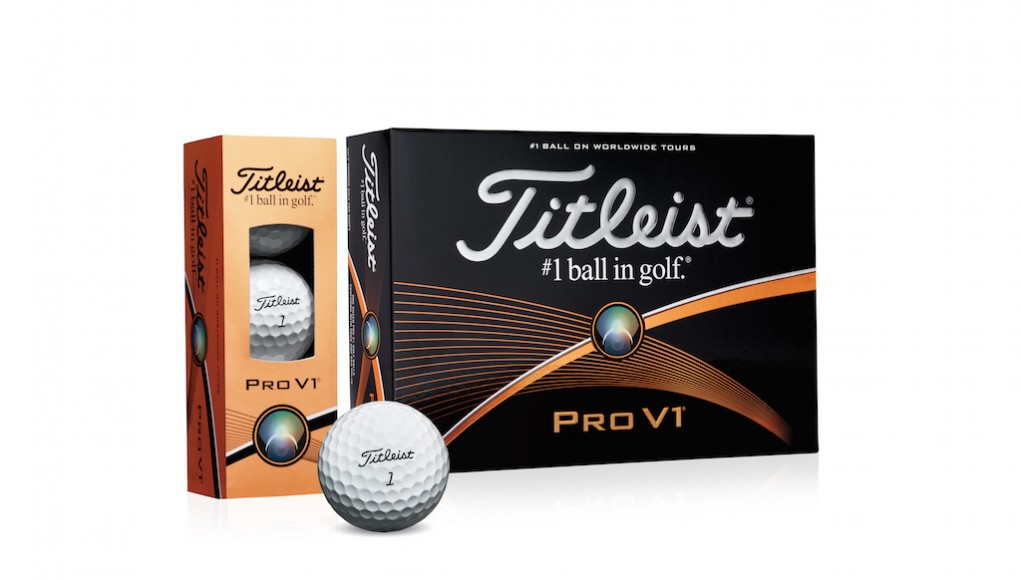
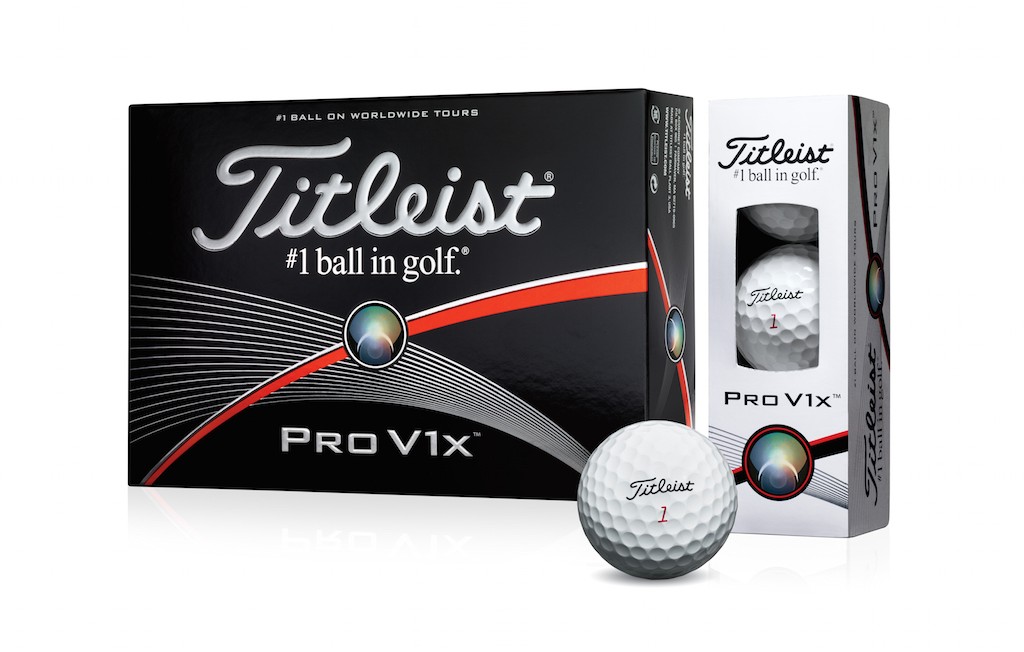
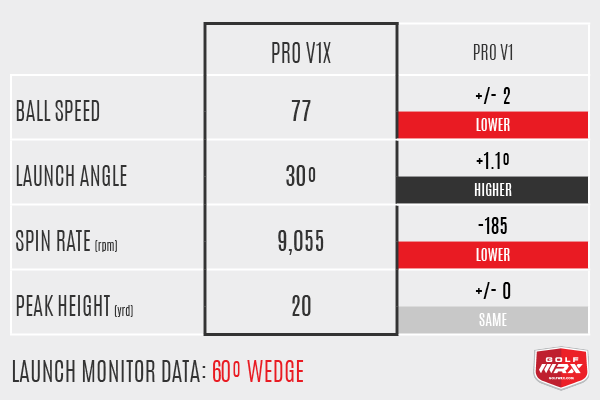
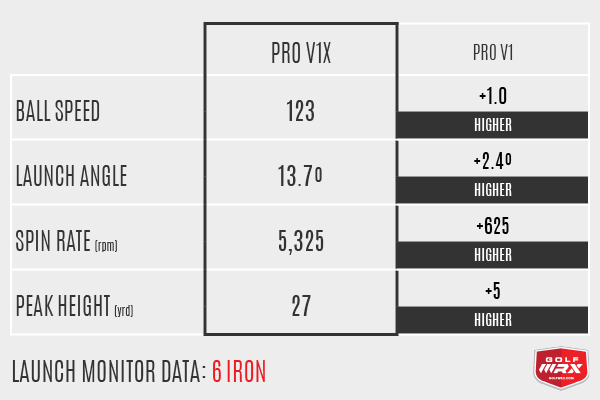
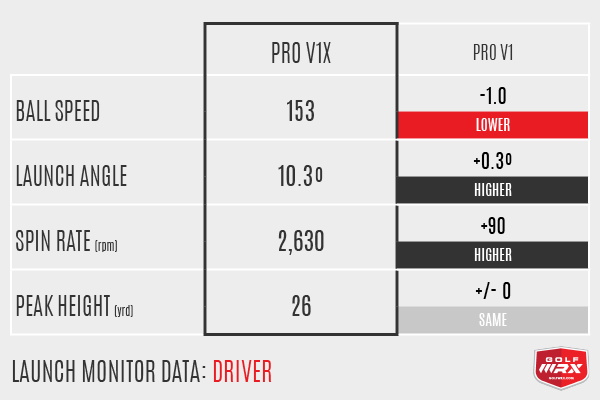
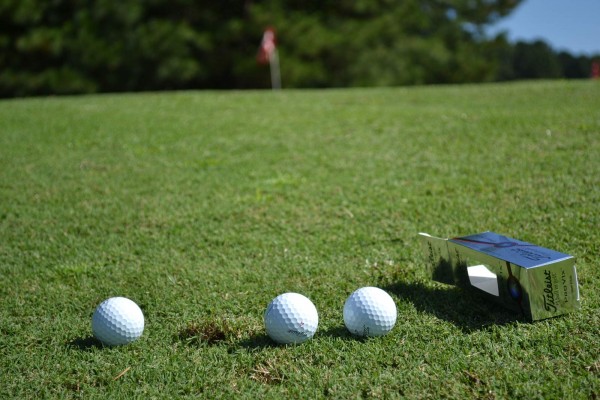
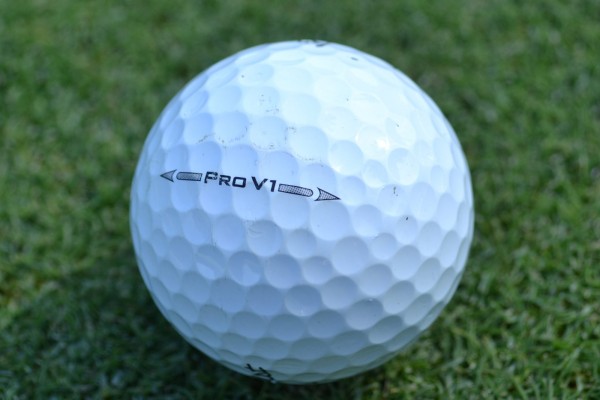














Carlos
Apr 30, 2017 at 11:04 am
Wow all these touring pros with 100 plus swing speeds, amazing. Really people?
Dan
Aug 30, 2016 at 10:52 pm
Great Review! I’m using Titleist but I the Chrome soft are amazing too.
Pat
Mar 31, 2016 at 6:23 pm
I tried a sleeve of these balls and they didn’t make the cut. Normally I play the ProV1x and Hex black as my swing speed can get up to 122mph. Cally soft launched too high for me and I was losing 10-15 yards as a result. I tend to hit a draw and my miss is a hook. This ball seemed to launch higher and straighter but spun too much and I was losing distance with my irons as well. I gave my father the rest of the sleeve of Cally soft and he was doing great. His swing speed is around 105mph and is a naturally very low ball hitter so the higher launch and extra spin benefited him greatly.
Ben Ross
Jan 17, 2016 at 2:58 pm
Great ball. I have a SS of 108-110 with the driver and it’s def shorter than the Pro V1x and Srixon ZStar XV for me. Off irons it seemed higher launch, slightly less spin, same distance. With Wedges it was much higher launch and def less spin that the Pro V1/1x and ZStar XV. I have an Odyssey White Hot insert putter and a MetalX putter and it almost felt too soft off the face. Ideally, I like more feedback and a firmer feel of the putter face.
I’ve only played the Optic Yellow. I’d say it feels more like the NXT Tour or NXT Tour S. I felt that on chips, it launches higher than Pro V1x with less spin. Maybe it’s bc of how it feels off the face, but I tend to hit chips higher and get more rollout. With all iron shots, I felt like I could take dead aim. I also play the ZStar XV in Tour Yellow which I feel more closely mirrors the Pro V1x in all aspects.
With the Chrome Soft, I felt like there was much less sidespin and at times I hit it too straight (I know doesn’t sound like a problem right?). It held its line so well into the wind but it flew high for me. I had a hard time working the ball and often was missing fairways and greens, bc the ball didn’t react how I expected. In trying to shave off the last few strokes off my handicap, it’s critical to work the ball away from trouble and aim at center green, working it back to the pin. I wasn’t as confident doing that with the Chrome Soft. I’d love to see Callaway make the Chrome Soft in Tour Yellow, with a slightly firmer feel. Maybe call it the Chrome Soft X.
Chuck Zirkle
Jan 13, 2016 at 8:18 pm
Have tried the Chrome Soft and the new Titleist DT Trusoft is its twin, except $10 less. The distance is good with both as well as spin on the green. Really am an advocate for Titleist balls so it is a no brainer at that price. Good winter ball.
Chuck Zirkle
Jan 13, 2016 at 8:14 pm
Titleist new ball, DT Trusoft cannot tell difference in it’s performance and the Chrome Soft and $10 less in price. I normally play the Prov1 but got my hands on a sleeve of the DT Trusoft. Tried both balls and it performs well in comparison to the Chrome Soft. Good distance, control and bites well on the greens.
Nocklaus
Jul 14, 2016 at 10:43 pm
You can not really compare a urethane ball with a surlyn ball…
Kevin Hawkins
Jan 1, 2016 at 5:27 pm
I find a lot of the comments difficult to judge without knowing the experience or the handicap of the person making the comments.
For example, if one is stating the Pro V1 is a better ball than the Chrome Soft, if the commenter is a single figure golfer, I am more inclined to accept his comments.
Conversely, if the commenter is a 20 plus handicapper comparing balls, I am more inclined to come to the opinion, he doesn’t really know what he is talking about other than he prefers one ball over the other.
Does that make sense?
One would be able to
Jack Nash
Jan 25, 2016 at 10:06 am
I’m a 6 and switched from the Pro V’s. More distance and the same feel around the green.
Jack Nash
Nov 25, 2015 at 12:57 pm
Played ProV’s for years And decided to give the Softs a try. I found my new ball. Better yet they come in yellow. A lot easier for these old eyes, plus Ive gained at least 5 yards off the Tee.
BJ Westner
Nov 17, 2015 at 10:46 am
I just played with these this past weekend. Initially I loved the way they felt off the putter. The problem that I ran into is that because they are lower compression than what I normally play (Pro V1), they rolled out much further. So while they were great feeling off the putter face, I found it very difficult to get distance right on putts.
Also, these balls did not have the same amount of spin that the Pro V1 has. I hit shots that I expected to check up and that I know the Pro V1 would check up with and these did not. With that being said, I found myself constantly missing greens long this past weekend (I played both Sat and Sun) because the balls were going that much further. It was also cold this past weekend which may have exacerbated the issue but I was impressed with how far they went. The price is nice if you buy balls at the retail price. I don’t though. I usually get new Pro V1’s online and buy several boxes for somewhere around 35 bucks or so which makes the price point the same as with the Chrome Soft. The Chrome Softs were durable and again, I loved how they felt coming off the putter, unfortunately because of the lower compression they went much further when putting. Overall not a bad ball. I normally do not try other balls and stick to what I usually play. Because it was getting colder out where I live (DC area) I thought a lower compression ball might be good to play all winter. I am undecided on whether I will play them again or not – I’m on the fence. My overall opinion is that the author of the article made these out to be much better than they are. They are not bad, but they are not Pro V1’s either.
John
Feb 26, 2016 at 10:50 pm
Felt the same… 3 putted more times with these in a week than I did with my ProV1x’s in 2 years
Bill Mac
Apr 10, 2016 at 11:54 pm
What has the compression of a golf ball got to do with how far it travels when putting? I’m a little lost on this one.
OhioGolfDude
Nov 4, 2015 at 10:08 am
Love the SuperSoft and have hit my longest drives ever with that ball. Tried the Chrome Soft and they nail it too with more spin. What’s not to love?
Mike Berger
Oct 28, 2015 at 7:34 pm
Best ball I ever played, beats Pro V hands down.
MAtto
Oct 28, 2015 at 4:43 pm
“Your 10ft putt for birdie is now 29ft”?
What about “Your 10ft putt is now 0ft”?
KC
Oct 28, 2015 at 2:02 pm
I’ve tried the ChromeSoft ball on multiple occasions and just cannot get along with it. I didn’t find it to be nearly as durable as the Bridgestone B330 or Srixon Z-Star lines, nor did it perform as well for me. Of course, that’s a sample of one. I’ve got plenty of friends who swear by the ChromeSoft, so it’s good that there are plenty of options out there today.
Great review!!!
Troy
Oct 28, 2015 at 1:37 pm
I have been playing the Chrome Soft since June and absolutely love this ball.
My driver SS is 107 mph and haven’t lost any distance off the tee, where I noticed the biggest difference is with my irons and wedges.
I’ve gained approx. 3-5 yards with all my irons and wedges, which took a bit to get used to.
The ball putts like a dream, incredibly soft.
I will agree with a few other reviewers that state they don’t seem to get the same amount of spin with the CS as I had gotten with the SR3.
Overall it’s a great ball for a great price.
A vast majority of golfers playing a ball like the ProV1 are wasting their money playing a ball not suited for their swing speed and game.
They would be better suited going to a ball like the Chrome Soft and saving their $$$.
myron miller
Oct 28, 2015 at 1:32 pm
I’ve tested these several times and have some serious problems with them. First off, I’m a older senior with a slower swing speed (probably in mid 70s). The ball feels mushy and doesn’t travel anywhere near as far as a harder ball does. usually lose 10-20 yards most of the time. Some friends with faster swing speeds (mid upper 80s) have better luck with the ball and it does travel for them about same as regular ball but not as good as Chrome plus.
Secondly, they are very hard to be consistent on the greens with due to softness (mushy feel as others have complimented). And again harder to control distance on chips.
So summary for me is way too soft and inconsistent short game and since that’s the only way I can score is thru the short game, they definitely are not for me, an older player.
Definitely really not for most seniors in my opinion.
Clarence
Oct 28, 2015 at 12:38 pm
These people stole your review: (link removed)
Zak Kozuchowski
Oct 28, 2015 at 1:22 pm
Thank you for letting us know, Clarence.
Clarence
Oct 28, 2015 at 2:02 pm
np. Love your work, not so keen on stealing 🙂
Da mob
Apr 21, 2017 at 9:47 pm
Snitches get stitches….
Walt
Oct 28, 2015 at 12:23 pm
This is the best ball I’ve played for the money. Short game has been better since I started using it
possum
Oct 28, 2015 at 9:59 am
This ball has been out a long time. Why the review just now as they are phasing it out? Isn’t the new Chrome Soft successor about to hit the shelves?
Stephen Jacobs
Oct 28, 2015 at 8:18 am
I am 68 with a driver swing speed of 85-88 mph.I played the Callaway super soft ball last winter in Florida and gained around 10 yards on my drives but had trouble holding the ball on the green. I switched to the Chrome soft and hit my drives just as far and had better success on my approach shots to the green.
Tred Vice Pro balls and gained 10 yards on my drives and had great stopping ability on approach shots.
Marco
Oct 28, 2015 at 8:05 am
My driver SS is about 115. Do this ball generate more spin than the other premium balls like SR3, V1 TP?
Kalle
Oct 28, 2015 at 4:18 am
Just my 5 cents, but I’ve noticed that all the reviews seem to value softer balls more highly regarding putting. In my experience putting with a soft feeling milled putter, I actually like the feel of harder balls much better. Putting with a soft ball gives me the sensation of rolling with a marshmellow.
Globus
Oct 27, 2015 at 10:48 pm
Played these balls all summer long. Don’t check as well on the greens as the reviewer suggests.
Also tough to control on Lag putts. RZN Black is the best one right now.
RHJazz
Oct 27, 2015 at 9:40 pm
I agree with all the main review points and really liked these on stock full swings, but as a previous poster noted, they seemed just a touch less predictable with my short game and I had trouble keeping the flight low when needed. An excellent ball especially if you like soft feel, but I found the Snell My Tour Ball was better for me. I play in a lot of wind and varied conditions in Texas and although it doesn’t have the same soft feel as the Callaway, it performs better for my game. Doesn’t hurt that the Snell is $6 a dozen less too.
Rich
Oct 27, 2015 at 8:27 pm
These feel like a rubber ball. Couldn’t get past the mushy feel with all clubs. Too soft in my opinion.
jc
Oct 27, 2015 at 7:31 pm
it should have been compared to the sr-1 and sr-2, more people play those models…and now they are all going away…dumb move by callaway
Pingback: Chrome Soft Receives Perfect Score In GolfWRX Review | Callaway Golf News and Media
Joe
Oct 27, 2015 at 6:01 pm
This review is a little out-of-date because the new Chrome Soft with higher compression are coming out in the next few weeks. Thanks for the writeup – a good ball – a little soft off the putter.
jgpl001
Oct 27, 2015 at 5:40 pm
Currently playing the NXT Tour S and a total Titleist diehard…
Tried these Callys recently and was very impressed, these are very good balls and great value
My good experience with these prompted me to try a pair of raw Mac Daddy 2 forged wedge – Vokeys now out of the bag….
Let’s see if my new found love for Callaway continues…..these Chrome Soft’s may have started me on a new journey!
Mark
Oct 27, 2015 at 4:02 pm
I shall beg to differ on short game spin. The CS is so soft it is actually very hard to judge when and when it won’t spin. And in my playing conditions, firm course for most of the summer it didn’t perform as well as a V1 or Z-Star. It is cheaper because the performance is not quite premium ball level. It is an excellent ball for mid hcp players and better than NXTs but in no way a tour level ball.
Chris
Oct 27, 2015 at 3:36 pm
Great review! I have found the chrome soft to be the same as Kane described in his review. My SS is 111mph and I do not find any distance loss with my driver compared to other tour balls. Like I told Callaway earlier this year. Chrome soft is the ball to beat. Move over titleist.
killerbgolfer
Oct 27, 2015 at 3:18 pm
Great review. I’d love to see how these stack up against other brands at this price point, NXT Tour, etc.
Mike
Oct 27, 2015 at 2:56 pm
The Chrome soft is the real deal. No other ball has been so close to bumping the pro v1x from my bag.
Rich
Oct 27, 2015 at 12:58 pm
I’ve been playing this ball since it first came out and it’s given new life to my game. I hope this ball stays around for a long time.
Philip
Oct 27, 2015 at 12:44 pm
Interesting – first Callaway (like a few others) states that there should be a ball for different swing speeds – now they are saying one ball for almost all swing speeds too … sounds familiar. Technology for golf has truly become like fashion – just keep going in circles while making sure enough time has progressed between the new fashion trend “I mean technology”.
Desmond
Oct 27, 2015 at 1:30 pm
It’s a compromise. No consumer wants to admit a low swing speed, so they don’t buy the ball. Great idea, and if they had continued, the 2nd generation of SR balls would have improved – probably based on the Chrome Soft.
Philip
Oct 27, 2015 at 5:03 pm
Very true – since I use what works and only care about my final score I tend to forget that the OEMs are really catering to the consumer’s ego for the majority.
Brian
Oct 27, 2015 at 12:30 pm
They’re very popular at my club. I play them when I’m out of Nike RZN Black and need some playing balls.
Tom
Oct 27, 2015 at 11:57 am
I’ll give these a try, who knows maybe it will replace chrome black I’ve been scramblin to find.